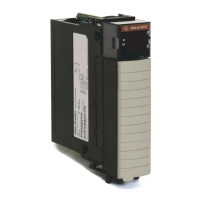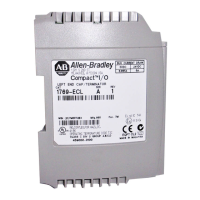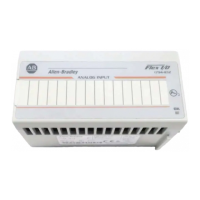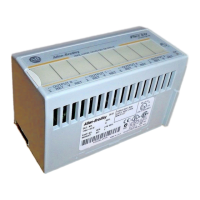50 Rockwell Automation Publication 1756-UM540E-EN-P - December 2017
Chapter 3 1756-IF8I Isolated Analog Input Module
Rate Alarm
The rate alarm triggers if the rate of change between input samples for each
channel exceeds the specified trigger point for that channel. The actual rate of
change for the last sample is returned in the Ch[x].RateOfChange input tag of
each channel.
To see where to set the Rate Alarm, see page 137
.
Sensor Offset
The sensor offset compensates for any known error on the sensor or channel to
which the sensor is connected. The value is set in signal units and is added to the
data value.
For example, if the sensor has an error such that the channel consistently reports
current signal values by 0.2 mA lower than the actual value, you set this parameter
to 1.25% in channel configuration if using the default scaling of 4…20 mA =
0…100%.
You set this value via the module output tags. That is, tag O.Ch[x].SensorOffset.
Where x represents the module channel.
In the example above, the O.Ch[x]SensorOffset tag = 1.25.
If scaling mA to mA, if you configure a channel’s rate alarm to 1.0 mA/s, the rate alarm triggers
only if the difference between measured input samples changes at a rate > 1.0 mA/s.
Consider the following conditions:
• The module’s RPI is 100 ms, that is, new data is sampled every 100 ms.
• At input sample 1, the channel measures 5.0 mA.
• At input sample 2, (100 ms later) the channel measures 5.08 mA.
At this sample instance, the rate alarm is not triggered because the rate of change is less
than 1.0 mA/s.
The rate of change is 0.8 mA/s [(5.08 mA - 5.0 mA) / (100 ms)].
• At input sample 3 (100 ms later) the channel measures 4.9 mA.
At this sample instance, the rate alarm is triggered because the rate of change is greater
than 1.0 mA/s.
The rate of change is 1.8 mA/s. [(4.9 mA - 5.08 mA) / (100 ms)].
At this sample instance, the absolute value of this result is > 1.0 mA/s, so the rate alarm sets.
Absolute value is used because rate alarm checks for the magnitude of the rate of change
being beyond the trigger point, whether a positive or negative excursion.

